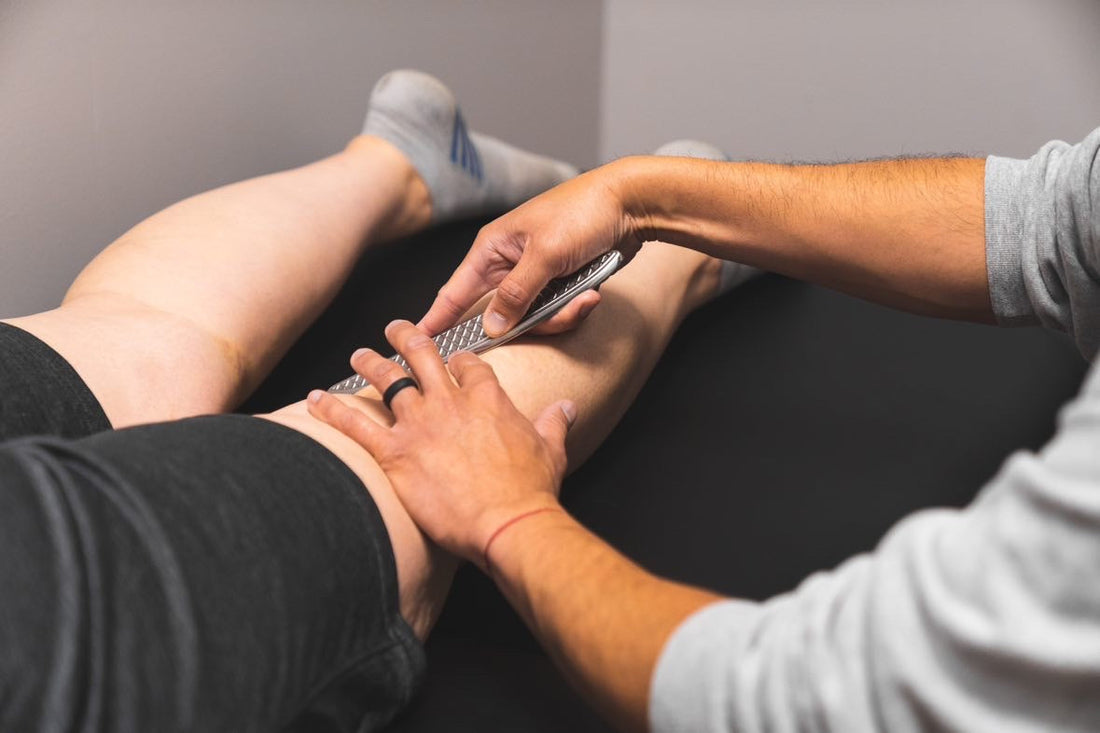From Ancient Techniques to Modern IASTM
Instrument Assisted Soft Tissue Mobilization (IASTM) has roots going back thousands of years. The Greeks and Romans used a tool called the strigil, while in Chinese medicine it is known as gua sha. Today, IASTM is a proven technique in physical therapy and sports medicine, using precision-engineered tools to detect and treat soft tissue restrictions. Clinicians now rely on IASTM instruments like HawkGrips to improve mobility, reduce pain, and accelerate recovery from injuries, chronic conditions, and post-surgical limitations.
What Is IASTM?
Instrument Assisted Soft Tissue Mobilization (IASTM), sometimes called “scraping,” is a form of manual therapy that uses stainless steel or hard plastic tools to mobilize muscles, fascia, and tendons. Unlike hands-only massage, the instruments allow clinicians to detect scar tissue, adhesions, and soft tissue restrictions with greater precision.
IASTM tools act as an extension of the hands, reducing strain on clinicians while enhancing treatment outcomes. Trained practitioners can feel subtle vibrations through the instruments, which helps them locate problem areas. Once identified, the tools are used to break down adhesions, restore mobility, and improve function. Importantly, they also help preserve the hands, fingers, and arms of clinicians. Manual therapy can be demanding. IASTM does not replace the hands, but it can be a supplement and enhance what they can already do.
Clinicians use IASTM to:
- Detect soft tissue abnormalities that may be contributing to pain.
- Address restrictions that, if left untreated, might otherwise require surgery or ongoing medication.
- Deliver precise treatment with tools designed to mobilize tissue safely and improve range of motion.
How Does IASTM Work?
Using HawkGrips IASTM tools, clinicians apply precise strokes, angles, and pressure to create a mild tissue response that triggers the body’s natural healing process. Blood flow to the area increases, delivering oxygen and nutrients while clearing out waste products. The treatment also releases tight spots and adhered tissue that may be limiting your movement. Over time, this can reduce pain, improve flexibility, and make everyday activities feel easier and more comfortable.

Who Can Benefit?
IASTM isn’t just for athletes. It can help workers with repetitive strain injuries, post-operative patients with scar tissue, and anyone with chronic musculoskeletal pain. Because clinicians can adjust treatment intensity, IASTM is safe and effective for patients of all ages, from pediatric to geriatric.
Conditions Treated
IASTM is effective for many soft tissue injuries and conditions, such as:
- Plantar fasciitis
- Carpal tunnel syndrome
- Neck and back pain
- Muscle strains
- Rotator cuff tendonitis
- Achilles tendonitis
- Patellar tendonitis
- Epicondylitis (tennis or golfer’s elbow)
- Shin splints
- Trigger finger
- DeQuervain’s syndrome
- Post-surgical and traumatic scars
- And many more

Patient Benefits
IASTM offers a range of benefits that make it an effective option for both acute injuries and chronic conditions:
- Pain relief – Reduces discomfort from muscle tension, tendinopathy, and scar tissue.
- Improved mobility – Restores joint range of motion by releasing tightness and restrictions.
- Immediate results – Many patients notice relief and increased movement after the first session.
- Enhanced recovery – Speeds healing after workouts, injuries, or surgery.
- Non-invasive – Provides an alternative to surgery or long-term pain medication.
- Efficient treatment – Maximizes session time by allowing clinicians to target problem areas quickly and effectively.
- Versatility – Effective for conditions such as plantar fasciitis, tennis elbow, carpal tunnel, rotator cuff injuries, and post-surgical scar management.
And while patients experience relief and faster recovery, clinicians also benefit. IASTM makes treatments more efficient and effective without putting added strain on their own hands.
Clinician Benefits
IASTM doesn’t just support patients– it also helps clinicians deliver effective care while protecting their own long-term health.
- Hand preservation – Tools reduce the physical strain and fatigue of manual therapy, helping clinicians protect their most valuable asset: their hands.
- Targeted therapy – Different tool shapes and beveled edges let clinicians reach both broad areas and small, hard-to-treat spots effectively.
- Improved efficiency – Streamlines treatment by quickly identifying and addressing tissue restrictions.
- Versatile tools – Adaptable for a wide range of conditions, from acute injuries to chronic pain and post-surgical rehab.
“I believe the greatest gifts as a clinician are our hands. HawkGrips are a great way of saving our hands from the abnormal wear and tear that is required when performing hands-on therapies such as fascial dysfunction and breaking up adhesions. The use of HawkGrips has been a great adjunct to my rehabilitation of our players."
-Jim McCrossin MS, ATC, CSCS, PES, CES
Athletic Trainer & Strength & Conditioning Coach, Philadelphia Flyers
What to Expect in a Session

A typical IASTM session begins with a warm-up, followed by targeted treatment using the IASTM tools on the affected area and surrounding tissues. The clinician applies an emollient to help the instruments glide smoothly and reduce friction on the skin. Mild discomfort and slight redness or discoloration may occur as circulation improves, which is normal. Treatments are often combined with stretching, strengthening, cupping, taping, and patient education for optimal results.
Why IASTM Works
IASTM isn’t a cure-all, but it’s a highly effective tool when used by trained clinicians. This proven therapy directly addresses soft tissue restrictions, helping patients reduce pain, restore mobility, and recover faster. With IASTM, patients can get back to the activities they love sooner, and clinicians can deliver more precise, efficient care.
Ready to learn more about how IASTM can help you or your patients? Explore our HawkGrips IASTM tools and educational resources to see how our instruments improve treatment outcomes.

